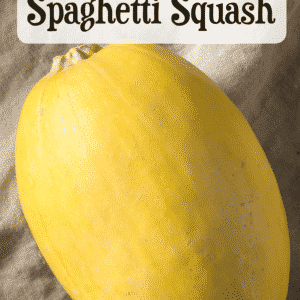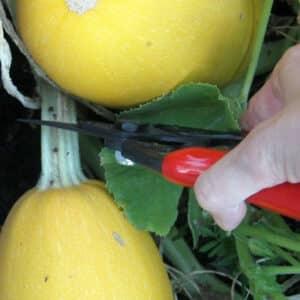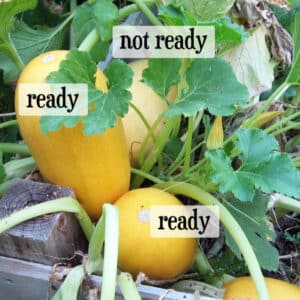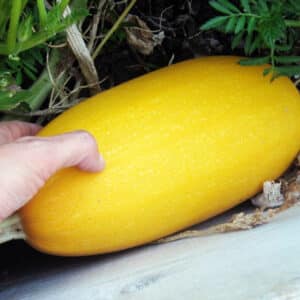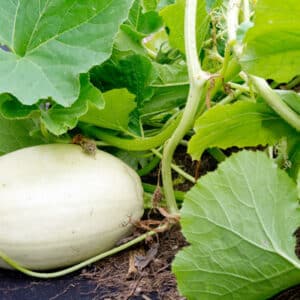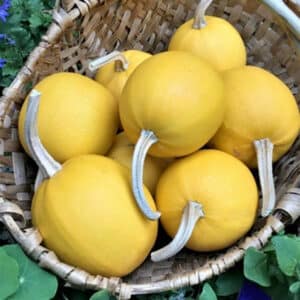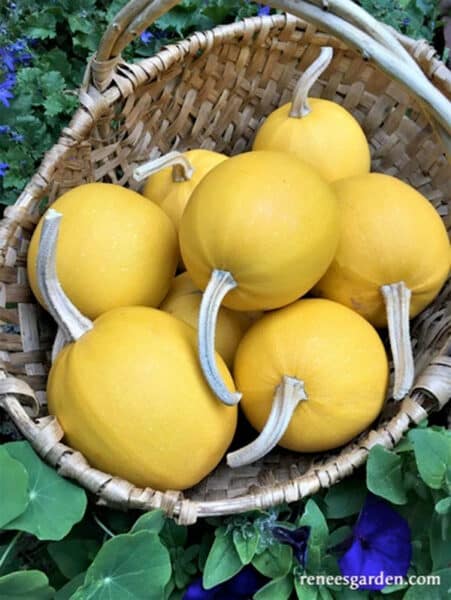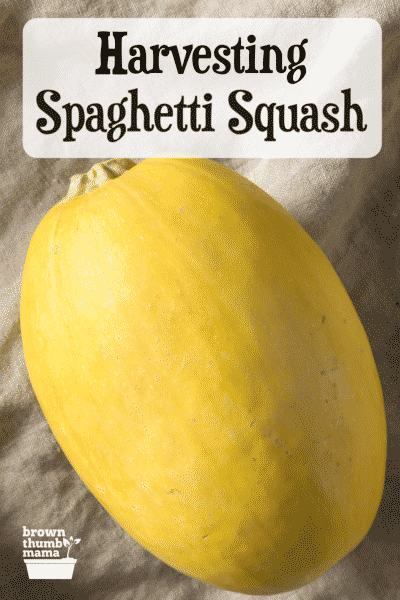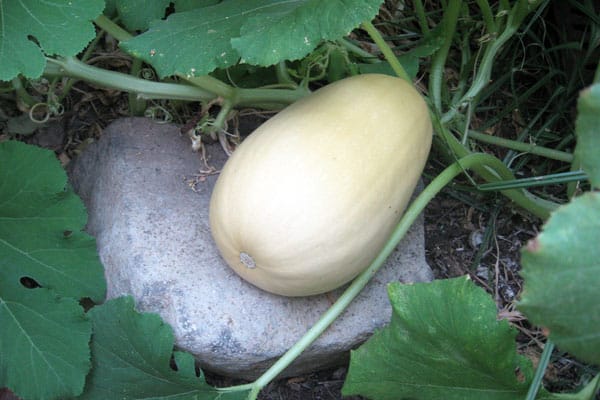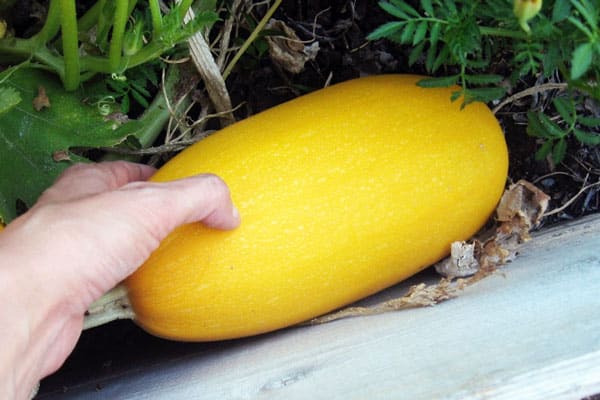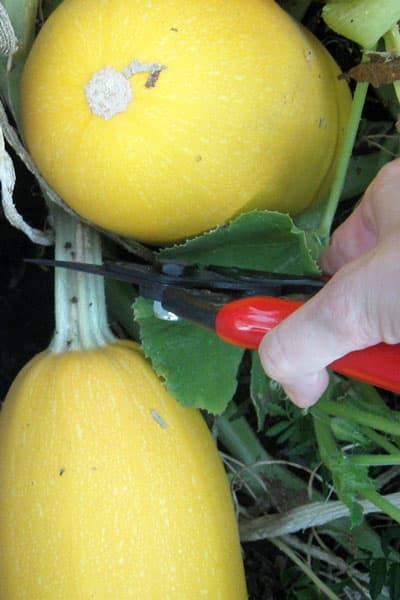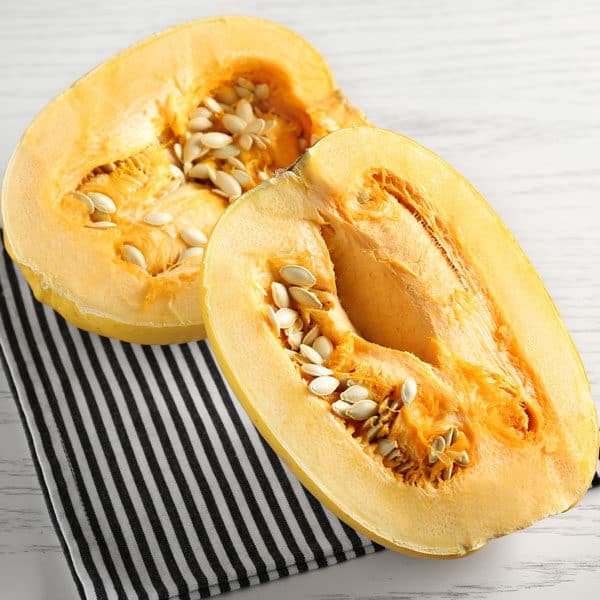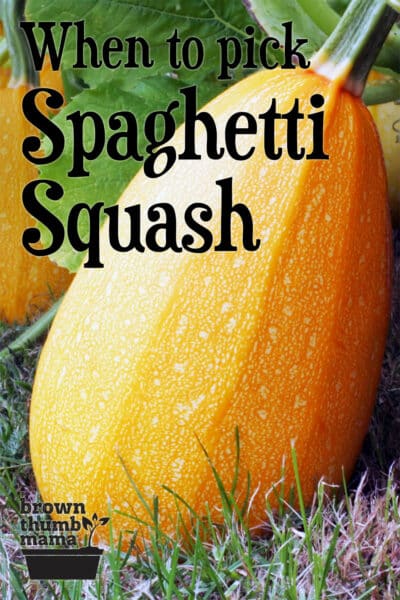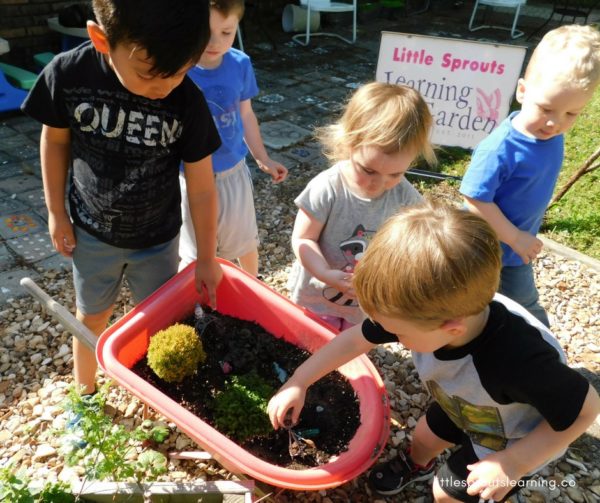This post may include affiliate links.
If you make a purchase, I'll earn a small fee at no extra cost to you.
It’s important to harvest spaghetti squash at the right time for maximum flavor. Here’s everything you need to know about when and how to harvest spaghetti squash.
Whether you call them spaghetti squash, vegetable spaghetti, vegetable marrow, or noodle squash, it can be tricky to know when these winter squash are ripe. When harvested at the right time, the inner flesh can be cooked and shredded into yummy, spaghetti-like strands you can use in place of pasta.
Spaghetti Squash Varieties
While all spaghetti squash belong to the same plant family (and are related to pumpkins, zucchini, and other squash), different varieties will be ready to harvest at different times.
Knowing the variety you’ve planted and its maturity date is the first step in knowing when to pick your spaghetti squash.
Baby Spaghetti (above), a semi-compact variety, is ready in 80 days.
Angel Hair, which grows on long vines, ripens in 88 days.
Vermicelli is a semi-bush variety that needs less space than Vegetable Spaghetti, and is ready in 90 days.
Vegetable Spaghetti ripens within 90-100 days and is the variety you’re most likely to see at the grocery store.
When to Harvest Spaghetti Squash
Spaghetti squash starts off a light green color, and matures to a dark yellow-orange when it’s ripe.
There are 4 main ways to know if your spaghetti squash is ready to harvest, and using a combination of these will ensure you’re picking them at the right time.
Seed Packet
The first way is the timing on the seed packet, as discussed above. If you don’t have the seed packet or the plants aren’t following the calendar properly, use the rest of the methods to be sure.
Rind Color
The next step is to check the color of the skin–ripe spaghetti squash is a deep, golden yellow color. See how the one hiding in the back is still pale? It needs to stay on the vine and grow a bit longer.
Rind Thickness
Once you’ve found a spaghetti squash that’s the right color, confirm that it’s ready to harvest by trying to pierce the skin of the squash with your fingernail. The skin should be thick and hard–you shouldn’t be able to poke through it.
Vines Turning Brown
When the spaghetti squash vine starts turning brown and dying, that’s a clue that it’s time for you to harvest.
How to Harvest
Please don’t pull the spaghetti squash off the vine with your hands! It’s quite possible that the stem will come off the squash, and it will rot.
Use a nice, sharp pruner or clean kitchen knife to cut it off the vine with about an inch of stem attached.
I absolutely LOVE this Felco F-6 pruner. It’s made for smaller hands, so I can use it easily without having to grab one handle with each hand (like I do with conventional pruners). Yes, the Felcos are a bit expensive, but they are sharp as all heck and cut through *everything* like butter.
You don’t need to wash your spaghetti squash after harvesting, because the water could promote mold growth and spoilage. Wipe off any excess dirt and if storing, allow the squash to cure for a few days.
How to Cure Spaghetti Squash
If you’re eating your spaghetti squash right away, you don’t need to worry about curing it. Curing is used when you want to store your spaghetti squash to enjoy over the winter.
Note: if the squash has any damage or breaks in the skin of the squash, don’t attempt to cure it. Cut off the damaged parts and cook it within a day or two.
To cure spaghetti squash, place it in a spot with good ventilation and let it sit for 5–7 days at 80–85°F. Depending on the weather at harvest, you can cure spaghetti squash outside or inside. I prefer to cure mine indoors, since there are lots of hungry critters outdoors.
When you allow your spaghetti squash to cure, it lengthens its shelf life considerably. Curing also concentrates the squash’s natural sugars and helps reduce the chances of spoilage.
Storage After Harvest
Once your spaghetti squash has cured completely, it will happily sit on your kitchen counter or another cool place for up to 2 ½ months.
Don’t refrigerate your squash–although the fridge is cold, it’s too damp and your spaghetti squash will rot.
Saving the Seeds
If your spaghetti squash harvest was amazing and delicious, you might want to save the seeds for next year. This is a great idea! If the plants are heirloom or open-pollinated (not hybrid) then you can save the seeds and replant them.
The easy way: scrape all the seeds out and separate them from the stringy fibers. Allow to dry completely on a paper towel or cookie sheet and discard any seeds that are flat/empty. Store in a labeled envelope or canning jar in a cool, dry area.
The official way: scrape out all the seeds and fibers, and plop them into a clean bucket that’s half full of water. Allow this mixture to sit and ferment for 3 or 4 days. The viable seeds will sink to the bottom and the bad seeds and pulp will float. (I really feel like there’s a joke here…)
Put the bad seeds and pulp into your compost pile and spread the good seeds out on a paper towel or cookie sheet. Allow them to dry completely and store in a labeled envelope or canning jar in a cool, dry area.
Spaghetti Squash FAQs
Will spaghetti squash ripen off the vine?
Maybe. If there’s a frost coming, definitely pick them since they won’t survive the frost. If the squash is still green and soft, I’d say probably not. I haven’t had any success ripening green ones off the vine.
If it’s full-sized and starting to turn yellow, your chances are pretty good. Harvest as shown above, and set the squash in a warm, sunny place. Rotate the squash every few days until it’s a lovely golden color throughout.
Can you eat green spaghetti squash?
Yes, you can cook and eat it just like zucchini or other summer squash.
How can I tell if my spaghetti squash is overripe?
If your spaghetti squash is still on the vine, it’s more likely to be damaged by critters than to spoil from being overripe. If you find and dark spots or mushy spots on your spaghetti squash, it could be spoiled. Best to put that squash in the compost bin and look for another that’s ready to harvest.
How do you cook spaghetti squash?
One of my favorite ways to make a fast dinner with spaghetti squash is to cook it in the Instant Pot (it only takes 7 minutes) and top it with homemade spaghetti sauce. Boom…dinner’s ready!

